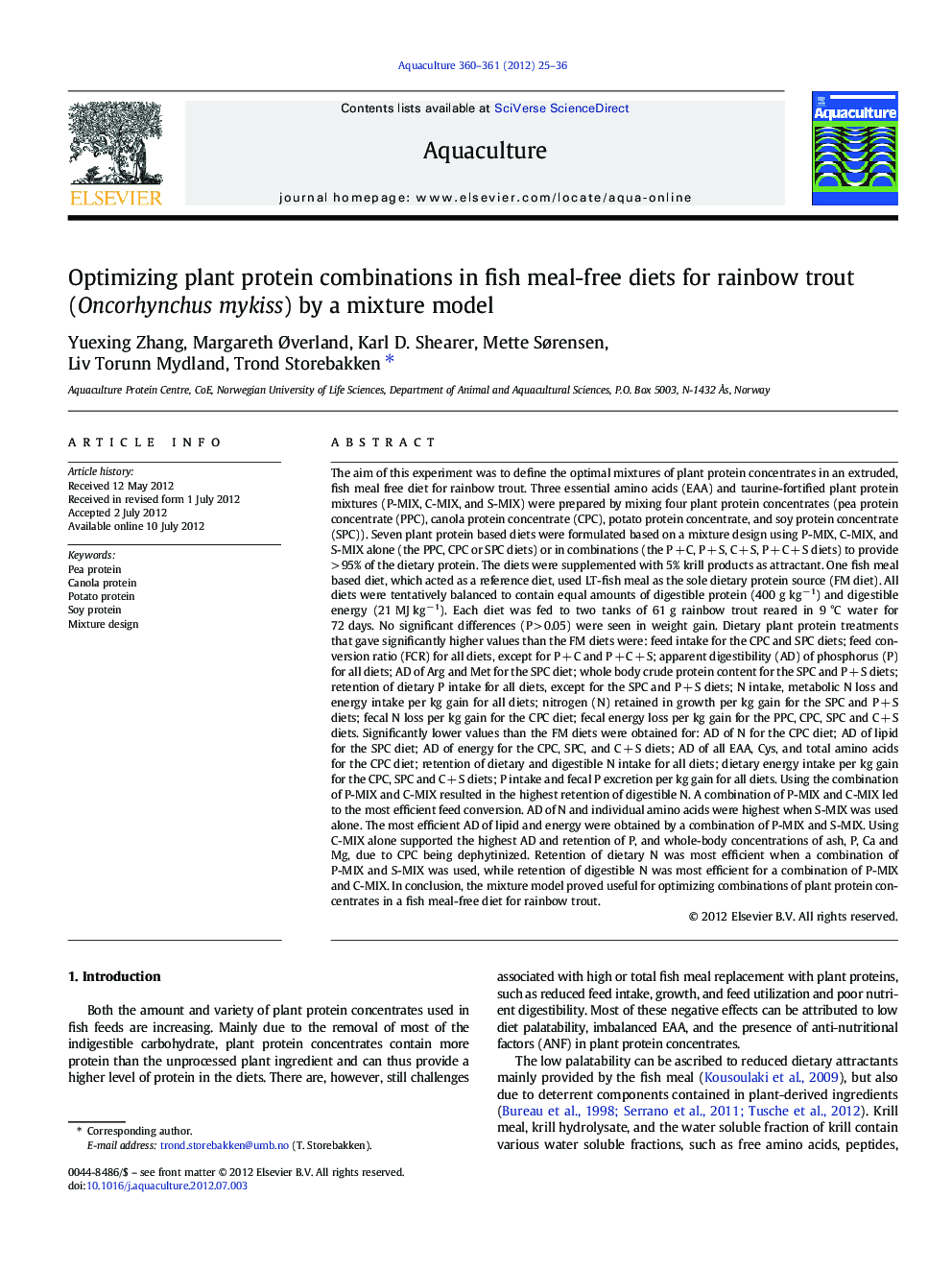| کد مقاله | کد نشریه | سال انتشار | مقاله انگلیسی | نسخه تمام متن |
|---|---|---|---|---|
| 2422433 | 1552886 | 2012 | 12 صفحه PDF | دانلود رایگان |

The aim of this experiment was to define the optimal mixtures of plant protein concentrates in an extruded, fish meal free diet for rainbow trout. Three essential amino acids (EAA) and taurine-fortified plant protein mixtures (P-MIX, C-MIX, and S-MIX) were prepared by mixing four plant protein concentrates (pea protein concentrate (PPC), canola protein concentrate (CPC), potato protein concentrate, and soy protein concentrate (SPC)). Seven plant protein based diets were formulated based on a mixture design using P-MIX, C-MIX, and S-MIX alone (the PPC, CPC or SPC diets) or in combinations (the P + C, P + S, C + S, P + C + S diets) to provide > 95% of the dietary protein. The diets were supplemented with 5% krill products as attractant. One fish meal based diet, which acted as a reference diet, used LT-fish meal as the sole dietary protein source (FM diet). All diets were tentatively balanced to contain equal amounts of digestible protein (400 g kg− 1) and digestible energy (21 MJ kg− 1). Each diet was fed to two tanks of 61 g rainbow trout reared in 9 °C water for 72 days. No significant differences (P > 0.05) were seen in weight gain. Dietary plant protein treatments that gave significantly higher values than the FM diets were: feed intake for the CPC and SPC diets; feed conversion ratio (FCR) for all diets, except for P + C and P + C + S; apparent digestibility (AD) of phosphorus (P) for all diets; AD of Arg and Met for the SPC diet; whole body crude protein content for the SPC and P + S diets; retention of dietary P intake for all diets, except for the SPC and P + S diets; N intake, metabolic N loss and energy intake per kg gain for all diets; nitrogen (N) retained in growth per kg gain for the SPC and P + S diets; fecal N loss per kg gain for the CPC diet; fecal energy loss per kg gain for the PPC, CPC, SPC and C + S diets. Significantly lower values than the FM diets were obtained for: AD of N for the CPC diet; AD of lipid for the SPC diet; AD of energy for the CPC, SPC, and C + S diets; AD of all EAA, Cys, and total amino acids for the CPC diet; retention of dietary and digestible N intake for all diets; dietary energy intake per kg gain for the CPC, SPC and C + S diets; P intake and fecal P excretion per kg gain for all diets. Using the combination of P-MIX and C-MIX resulted in the highest retention of digestible N. A combination of P-MIX and C-MIX led to the most efficient feed conversion. AD of N and individual amino acids were highest when S-MIX was used alone. The most efficient AD of lipid and energy were obtained by a combination of P-MIX and S-MIX. Using C-MIX alone supported the highest AD and retention of P, and whole-body concentrations of ash, P, Ca and Mg, due to CPC being dephytinized. Retention of dietary N was most efficient when a combination of P-MIX and S-MIX was used, while retention of digestible N was most efficient for a combination of P-MIX and C-MIX. In conclusion, the mixture model proved useful for optimizing combinations of plant protein concentrates in a fish meal-free diet for rainbow trout.
► Similar growth in trout with 95% dietary plant protein as with LT fish meal only.
► Mixture modeling is useful to optimize diet composition.
► Combining dietary plant proteins is more efficient than single ingredient.
► Pea, Canola, and potato proteins combined gave best feed utilization.
► Soy protein concentrate was preferred for maximum protein digestibility.
Journal: Aquaculture - Volumes 360–361, 9 September 2012, Pages 25–36